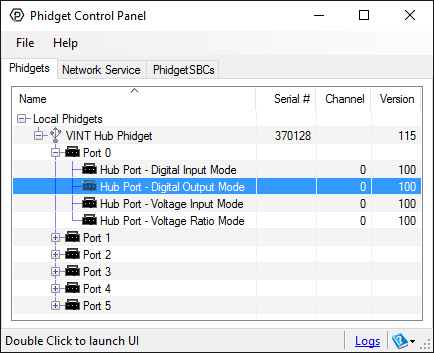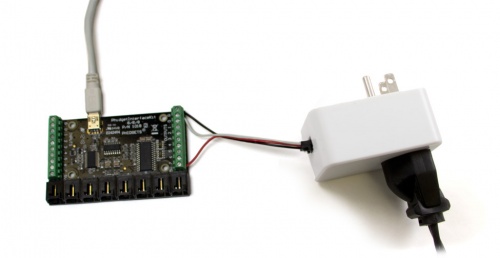PSU1000 User Guide
Getting Started
Welcome to the PSU1000 user guide! In order to get started, make sure you have the following hardware on hand:
- A PSU1000 Power Plug Phidget
- A VINT Hub
- Phidget cable
- USB cable and computer
- A device or appliance that uses a wall plug
Next, you will need to connect the pieces:

- Connect the PSU1000 to the VINT Hub using the Phidget cable.
- Connect the VINT Hub to your computer with a USB cable.
- Plug a device or appliance into the socket on the PSU1000.
Using the PSU1000
Phidget Control Panel
In order to demonstrate the functionality of the PSU1000, the Phidget Control Panel running on a Windows machine will be used.
The Phidget Control Panel is available for use on both macOS and Windows machines.
Windows
To open the Phidget Control Panel on Windows, find the ![]() icon in the taskbar. If it is not there, open up the start menu and search for Phidget Control Panel
icon in the taskbar. If it is not there, open up the start menu and search for Phidget Control Panel
macOS
To open the Phidget Control Panel on macOS, open Finder and navigate to the Phidget Control Panel in the Applications list. Double click on the ![]() icon to bring up the Phidget Control Panel.
icon to bring up the Phidget Control Panel.
For more information, take a look at the getting started guide for your operating system:
Linux users can follow the getting started with Linux guide and continue reading here for more information about the PSU1000.
First Look
After plugging the PSU1000 into your computer and opening the Phidget Control Panel, you will see something like this:

The Phidget Control Panel will list all connected Phidgets and associated objects, as well as the following information:
- Serial number: allows you to differentiate between similar Phidgets.
- Channel: allows you to differentiate between similar objects on a Phidget.
- Version number: corresponds to the firmware version your Phidget is running. If your Phidget is listed in red, your firmware is out of date. Update the firmware by double-clicking the entry.
The Phidget Control Panel can also be used to test your device. Double-clicking on an object will open an example.
Digital Output
Double-click on a Digital Output object in order to run the example:

General information about the selected object will be displayed at the top of the window. You can also experiment with the following functionality:
- Toggle the state of the digital output by pressing the button.
- Note: the PSU1000 is not designed to be used with Duty Cycle.
Finding The Addressing Information
Before you can access the device in your own code, and from our examples, you'll need to take note of the addressing parameters for your Phidget. These will indicate how the Phidget is physically connected to your application. For simplicity, these parameters can be found by clicking the button at the top of the Control Panel example for that Phidget.

In the Addressing Information window, the section above the line displays information you will need to connect to your Phidget from any application. In particular, note the Channel Class field as this will be the API you will need to use with your Phidget, and the type of example you should use to get started with it. The section below the line provides information about the network the Phidget is connected on if it is attached remotely. Keep track of these parameters moving forward, as you will need them once you start running our examples or your own code.

Using Your Own Program
You are now ready to start writing your own code for the device. The best way to do that is to start from our Phidget is compatible with the [https://www.phidgets.com/?view=code_samples&class=DigitalOutput DigitalOutput Examples. Code Samples].
Select your programming language of choice from the drop-down list to get an example for your device. You can use the options provided to further customize the example to best suit your needs.
Once you have your example, you will need to follow the instructions on the page for your programming language to get it running. To find these instructions, select your programming language from the Programming Languages page.
Technical Details
This plug contains a relay which is an electrically controlled switch. For more information about how mechanical relays work and how to use them, check the Mechanical Relay Primer.
Use with an InterfaceKit

In addition to plugging directly into VINT ports, the PSU1000 can be used with Interface Kits that have a Digital Output and 5V supply (like the 1018).
To connect the PSU1000 to the Interface Kit, cut one end off a Phidget Cable. Connect the red and black wires to the 5V and G terminals of the Interface Kit, respectively, and the white wire to the OUTPUT terminal you want to control the relay. Plug the end that still has a connector into the PSU1000.
To control the relay, open the DigitalOutput object for the channel the white wire is connected to. Setting the output state TRUE or FALSE will set the state of the relay.
Safety
Before you use a device or appliance with the PSU1000, please ensure that the power specifications fall within the appropriate range (100-240V AC, maximum 10amps).
Some devices don't operate properly when they have their power supply cut suddenly or frequently (e.g. computers usually need to be shut down before cutting power). You should read the user's manual for your device or appliance before using the PSU1000 to switch on and off.
What to do Next
- Programming Languages - Find your preferred programming language here and learn how to write your own code with Phidgets!
- Phidget Programming Basics - Once you have set up Phidgets to work with your programming environment, we recommend you read our page on to learn the fundamentals of programming with Phidgets.

